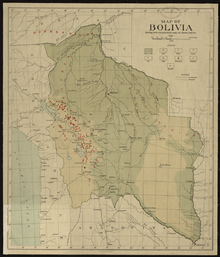
Back Minería en Bolivia Spanish Industrie minière en Bolivie French Гірнича промисловість Болівії Ukrainian
This article's factual accuracy may be compromised due to out-of-date information. (February 2011) |

Mining in Bolivia has been a dominant feature of the Bolivian economy as well as Bolivian politics since 1557. Colonial era silver mining in Bolivia, particularly in Potosí, played a critical role in the Spanish Empire and the global economy. Tin mining supplanted silver by the twentieth century and the central element of Bolivian mining, and wealthy tin barons played an important role in national politics until they were marginalized by the industry's nationalization into the Bolivian Mining Corporation that followed the 1952 revolution. Bolivian miners played a critical part to the country's organized labor movement from the 1940s to the 1980s.
By 1985, however, the production of every significant mineral in the country had failed to exceed the output registered in 1975.[1] Moreover, the international tin market crashed in 1985.[1] The mining sector in 1987 accounted for only 4 percent of GDP, 36 percent of exports, 2.5 percent of government revenues, and 2 percent of the labor force, compared with 8 percent of GDP, 65 percent of exports, 27 percent of government revenues, and about 6 percent of the labor force in 1977.[1] Spurred by a massive increase in gold production, however, the mining sector rebounded in 1988, returning to the top of the nation's list of foreign exchange earners.[1]
The crisis of 1985 prompted emergency economic measures by the government, including massive layoffs of miners. The twenty-first century has seen a recovery and expansion of the mining sector, and the government of Evo Morales has re-nationalized several facilities. However, as of 2010[update] mining in Bolivia is primarily in private hands, while the vast majority of miners work in cooperatives. Large, foreign owned mines such as Sumitomo's San Cristóbal mine also produce relatively large quantities of minerals. In 2010, 79,043 miners worked in the sector, producing $2.642 billion of mineral products.[2]
In 2017, mining and quarrying activities accounted for 9% of the GDP.[3] The mineral industry was estimated to have employed nearly 135,000 workers.[3]
- ^ a b c d
 This article incorporates text from this source, which is in the public domain. Rex A. Hudson and Dennis M. Hanratty, ed. (1989). Bolivia: A Country Study. Federal Research Division.
This article incorporates text from this source, which is in the public domain. Rex A. Hudson and Dennis M. Hanratty, ed. (1989). Bolivia: A Country Study. Federal Research Division.
- ^ "La minería generó al menos 22.000 empleos el año 2010". Página Siete. 2010-05-03. Archived from the original on 2012-03-17. Retrieved 2011-05-03.
- ^ a b Fong-Sam, Yolanda (2021). 2017-2018 Minerals Yearbook. U.S. Geological Survey.